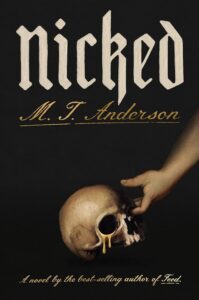“Books give delight to the very marrow of one’s bones,” said Petrarch. For me, that goes double for any novel set in the Middle Ages, those liminal centuries when ancient magic mixed with new religion, when love and war, feast and famine, walked hand in hand. This contradictory and chaotic period provides fertile ground for tales of crime.
Before toxicology reports or formal forensic analysis, and in the midst of omnipresent superstition, medieval detectives crack the case with the power of their own original logic. The stakes are always high; those in power kill quickly and with immunity, church law criminalizes autopsy, and individuals deemed “too clever” may find themselves accused of witchcraft.
Despite all this, the medieval detective is not grim and stoic: the so-called Dark Ages were also full of love and laughter. We see this in the bawdy writings of Chaucer and Boccaccio, in the Limbourg brothers’ delicate illumination of the month of August, where peasants swim as nobles in absolutely fabulous hats trot by on their tasseled ponies. Thus, when faced with Death, our detective greets him with an excellent joke.
In my novel The Stone Witch of Florence, Ginevra di Gasparo is recalled from years of lonely exile to catch a relic thief. Her sole qualification: a magical coral amulet that renders her immune to plague. When everyone else is dropping dead, she’s the only one who might live long enough to see the thing through. As Ginevra muddles her way through the investigation, she must face the tragedy and comedy of her time head on. “Death comes for everyone,” the gravedigger tells her. “Mocking it is the only way to remove its sting.”
The Stone Witch joins a rich tradition of medieval crime novels. Here are a few of my favorites:

The Name of the Rose by Umberto Eco
1327, Northern Italy
This is THE medieval mystery. It is thrilling and intricate and if you haven’t read it yet, I heartily encourage you to jump on the bandwagon. Brother William of Baskerville and his assistant, Adso of Melk, are called to a fraught theological meeting at a remote Benedictine Abbey. But upon arrival, the Abbot asks William to investigate a monk’s death. Soon, another brother is drowned in a vat of pig’s blood. The murders continue, and William must seek the killer in the monastery’s mysterious library.
 Version 1.0.0
Version 1.0.0
Mistress of the Art of Death by Ariana Franklin First of a series
1171, Cambridge, England
This fascinating and grotesque tale follows a female doctor as she battles bigots and her own shortcomings to track down a serial killer. Adelia Aguilar is a doctor to the dead, trained at the famed medical university in Salerno. She’s called to Cambridge (she’s not sure by who, exactly), to investigate the disturbing deaths of village children. The local population is quick to blame their Jewish neighbors, and not everyone is pleased with Adelia’s presence. She must uncover the real killer to save the lives of Cambridge’s Jews and her own.

A Morbid Taste for Bones by Ellis Peters First of The Cadfael Chronicles.
1137, Shrewsbury, England
Written in 1977, A Morbid Taste for Bones is the earliest book on this list, and is a source of inspiration for many writers of this genre. Brother Cadfael had his adventures as a crusader, and now is content to spend his retirement as a monk tending the abbey’s gardens. His quiet days are interrupted when he’s sent to Wales to acquire the relics of Saint Winifred. In Wales, not all the locals are willing to part with the relics, and the disagreement escalates to murder-by-mysterious-arrow. Some think the victim was struck down by St. Winifred herself, but Brother Cadfael has other ideas.

The Alewives by Elizabeth R. Andersen
1353, Colmar, Alsatia
We all like to be cozy sometimes, there’s no shame in it. The Alewives is a clever and not-too-dark medieval mystery that centers on friendship without falling into cringey, saccharine territory. Three women living on the poorest, grossest, street in Colmar need to put food on the table, so they join together to start a brewery (even though none of them actually know how to brew beer). When several neighbors end up dead in suspicious circumstances, the town sheriff is quick to dismiss these deaths of poor women as accidents. But the alewives know better, and for their own safety decide to take the investigation into their own hands.

Nicked by MT Anderson
1087, Bari, Italy
Nicked is a fantastic and original heist novel, based on the true story of the theft of the relics of St. Nicholas (yes, that St. Nick). St. Nicholas comes to the compulsively honest Brother Nicephorus in a dream and encourages him to help the poor. The monk’s superiors interpret the dream differently, and hire Tyun, a professional relic “liberator” to snatch St. Nick’s relics for their own city of Bari. Nicephorus is sent along with Tyun to recover the bones, but quickly becomes suspicious of the mercenary’s motives. Is he in the pay of Bari, or their rival, Venice? And also…is Tyun flirting with him?

The Lover by Laury Silvers First of the Sufi Mysteries Quartet
907, Baghdad
The setting alone makes The Lover worth a read, the mystery delicately unfolding inside a layered and richly described medieval Baghdad. Zaytuna, the reclusive daughter of a Sufi mystic, just wants to be left alone. But when a young girl stumbles into her home, seeking comfort after another child’s murder, Zaytuna feels called to seek justice for the ones at the very bottom of a strict social hierarchy.

The Queen’s Man by Sharon Kay Penman First of the Justin de Quincy Mysteries
1193, England
A fast-paced whodunnit set against the drama of Eleanore of Aquitaine’s court. Justin de Quincy, bastard son of a bishop, has just been thrown out of his home. Aimless and dejected, he encounters a dying man who thrusts a bloodied letter into his hands. The letter is for the Queen, and contains information about Eleanore’s missing son, Richard Lionheart. Now, Justin must deliver the letter, solve the messenger’s murder, and claim a place for himself in the Queen’s hostile court.
***


















